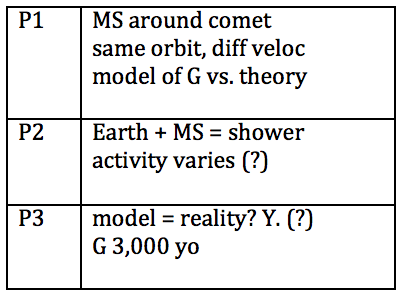-
Target Test Prep's 2024 GMAT Focus Edition prep is discounted for the BTG community!
Redeem
Find the Detail on GMAT Reading Comprehension
 Ive got another installment for you in the series on the Meteor Stream passage from the free set of practice questions that comes with the GMATPrep software.
Ive got another installment for you in the series on the Meteor Stream passage from the free set of practice questions that comes with the GMATPrep software.
This post contains the 4th of 5 questions that come with the passage. If you havent already, go read the first article (linked in the first paragraph); Im not going to reproduce the full passage here because its so long. When youre done, keep that passage open in another window and come back here. (Note: you can try the other questions first if you like, or you can come straight back here. Your choice.)
Ready for the question? Give yourself about 1.5 minutes to answer.
The Question
According to the passage, why do the dust particles in a meteor stream eventually surround a comets original orbit?(A) They are ejected by the comet at differing velocities.
(B) Their orbits are uncontrolled by planetary gravitational fields.
(C) They become part of the meteor stream at different times.
(D) Their velocity slows over time.
(E) Their ejection velocity is slower than that of the comet.
The Solution
First, identify the question type. According to the passage signals that this is a specific detail question. Youre going to have to find some specific detail in the passage and spit it back to answer the question.
Next, find the proof in the passage. Re-read the relevant text and try to formulate your own answer to the question.
Which paragraph talked about dust particles in the meteor stream?
Paragraph three was the whole model vs. reality thing. Paragraph two talks about how the model works. Paragraph one was the one that actually got into the details of the meteor stream.
Head over to the passage and think about how to answer this question while scanning the text for keywords dust particles or original orbit. It's right at the beginning:
A meteor stream is composed of dust particles that have been ejected from a parent comet at a variety of velocities. These particles follow the same orbit as the parent comet, but due to their differing velocities they slowly gain or fall behind the disintegrating comet until a shroud of dust surrounds the entire cometary orbit.
Put the message in your own words: the dust particles get ejected, but they still follow along with the comet. They have different velocities, though, so they end up spreading out around the orbit.
So why do the dust particles in a meteor stream eventually surround a comets original orbit? Because the different velocities make them spread out in a cloud.
Okay, time to eliminate wrong answers and look for the right one!
(A) They are ejected by the comet at differing velocities.
Bingo. This matches the predicted answer: the different velocities cause the particles to spread out. This is the correct answer.
(B) Their orbits are uncontrolled by planetary gravitational fields.
The third sentence of the first paragraph does mention planetary gravitational fields. But it talks about how the dust particles orbit might be perturbed, or disrupted, by these fields, not why the particles surround the comets orbit in the first place.
(C) They become part of the meteor stream at different times.
I think this one can be really tricky because you might imagine that this is the reason. It makes sense logically that this would happen at different times. However, the passage doesnt actually say anything about this.
(D) Their velocity slows over time.
This one is tempting because the passage does mention velocity, but it talks about differing velocities, not necessarily whether the particles are speeding up or slowing down (or maintaining a steady speed).
(E) Their ejection velocity is slower than that of the comet.
Ejection velocity sounds good, too! The first sentence does say that these particles are ejected at different velocities. The next sentence, though, says that the particles slowly gain or fall behind the comet. This implies that some might be slower than the comet but others are faster, so this statement isnt true of all of the particles. It also isnt why the particles eventually surround the orbit. The passage states that this is due to the different velocities.
The correct answer is (A).
Were you tempted by one of the other answers? Heres how to learn from the trap that the test writers were setting for you.
First, articulate why you thought that wrong answer was (or might be) right. For instance, answer (E) matches some detail language closely (ejection velocity), so that would likely catch your eye.
Next, articulate why that answer was actually wrong. In this case, the passage specifically cites a variety of velocities as the cause, not just slower velocities.
Finally, articulate why the right answer seemed like it could be wrong, and then dont forget to articulate why its actually right. Answer (A) may not look as good as (E) because it doesnt feature that language match from the passage. Answer (A) says differing velocities instead of a variety of velocities. These two phrases are synonyms, thoughthey mean the same thing!
Key Takeaways for RC Specific Detail Questions
(1) Make sure you go back to the passage to find the proof. As much as you can, try to predict (in your own words!) what the correct answer should say before you read through the five answers. This will help you to understand the meaning that you need, and youll be less likely to fall for a false language match trap, as described above.
(2) For all verbal questions (not just RC!), analyze the problem when youre done. If you were tempted by a wrong answer, ask yourself 4 things: (1) Why did this answer look good (even though its wrong)? (2) Why is it actually wrong? (3) Why did the right answer not look good in some way (ie, why would I consider crossing it off)? (4) Why is the right answer right?
* GMATPrep text courtesy of the Graduate Management Admissions Council. Usage of this question does not imply endorsement by GMAC.
This article is part of a Reading Comprehension series. Check out the other entries below:
Recent Articles
Archive
- June 2024
- May 2024
- April 2024
- March 2024
- February 2024
- January 2024
- December 2023
- November 2023
- October 2023
- September 2023
- July 2023
- June 2023
- May 2023
- April 2023
- March 2023
- February 2023
- January 2023
- December 2022
- November 2022
- October 2022
- September 2022
- August 2022
- July 2022
- June 2022
- May 2022
- April 2022
- March 2022
- February 2022
- January 2022
- December 2021
- November 2021
- October 2021
- September 2021
- August 2021
- July 2021
- June 2021
- May 2021
- April 2021
- March 2021
- February 2021
- January 2021
- December 2020
- November 2020
- October 2020
- September 2020
- August 2020
- July 2020
- June 2020
- May 2020
- April 2020
- March 2020
- February 2020
- January 2020
- December 2019
- November 2019
- October 2019
- September 2019
- August 2019
- July 2019
- June 2019
- May 2019
- April 2019
- March 2019
- February 2019
- January 2019
- December 2018
- November 2018
- October 2018
- September 2018
- August 2018
- July 2018
- June 2018
- May 2018
- April 2018
- March 2018
- February 2018
- January 2018
- December 2017
- November 2017
- October 2017
- September 2017
- August 2017
- July 2017
- June 2017
- May 2017
- April 2017
- March 2017
- February 2017
- January 2017
- December 2016
- November 2016
- October 2016
- September 2016
- August 2016
- July 2016
- June 2016
- May 2016
- April 2016
- March 2016
- February 2016
- January 2016
- December 2015
- November 2015
- October 2015
- September 2015
- August 2015
- July 2015
- June 2015
- May 2015
- April 2015
- March 2015
- February 2015
- January 2015
- December 2014
- November 2014
- October 2014
- September 2014
- August 2014
- July 2014
- June 2014
- May 2014
- April 2014
- March 2014
- February 2014
- January 2014
- December 2013
- November 2013
- October 2013
- September 2013
- August 2013
- July 2013
- June 2013
- May 2013
- April 2013
- March 2013
- February 2013
- January 2013
- December 2012
- November 2012
- October 2012
- September 2012
- August 2012
- July 2012
- June 2012
- May 2012
- April 2012
- March 2012
- February 2012
- January 2012
- December 2011
- November 2011
- October 2011
- September 2011
- August 2011
- July 2011
- June 2011
- May 2011
- April 2011
- March 2011
- February 2011
- January 2011
- December 2010
- November 2010
- October 2010
- September 2010
- August 2010
- July 2010
- June 2010
- May 2010
- April 2010
- March 2010
- February 2010
- January 2010
- December 2009
- November 2009
- October 2009
- September 2009
- August 2009
